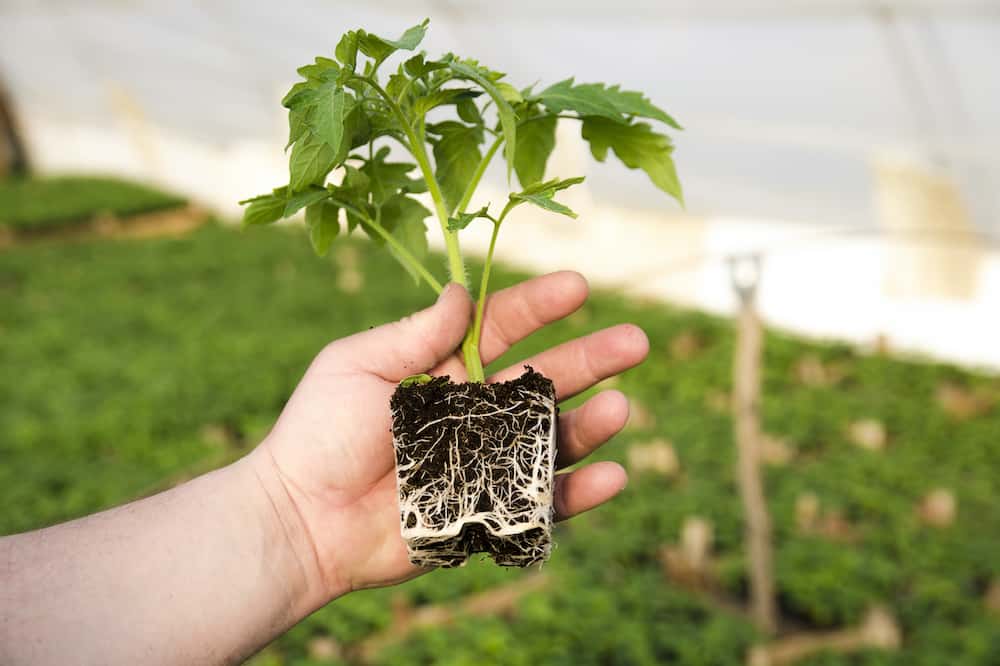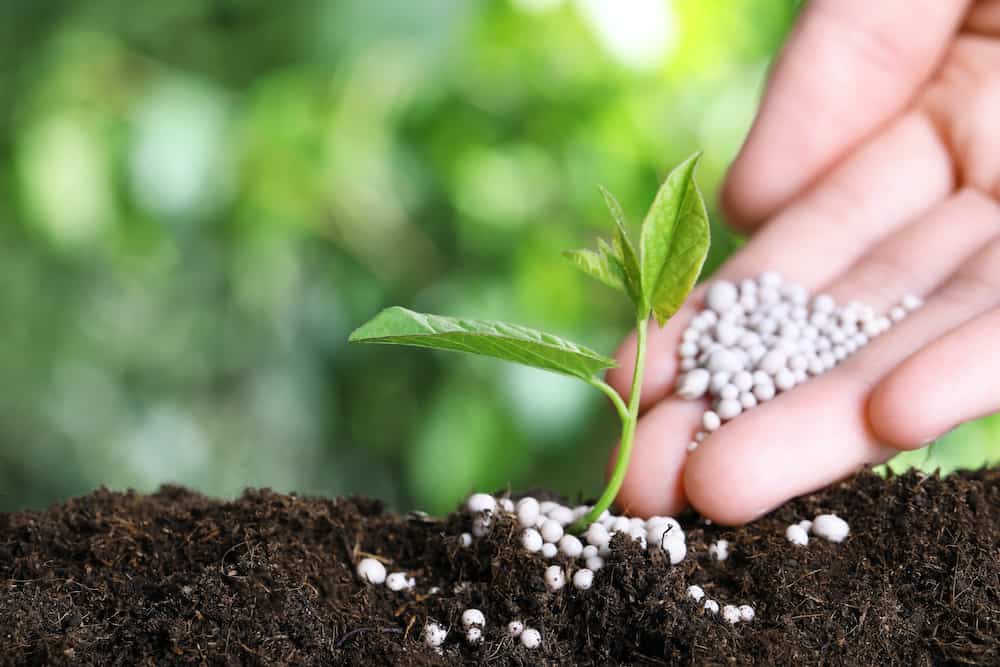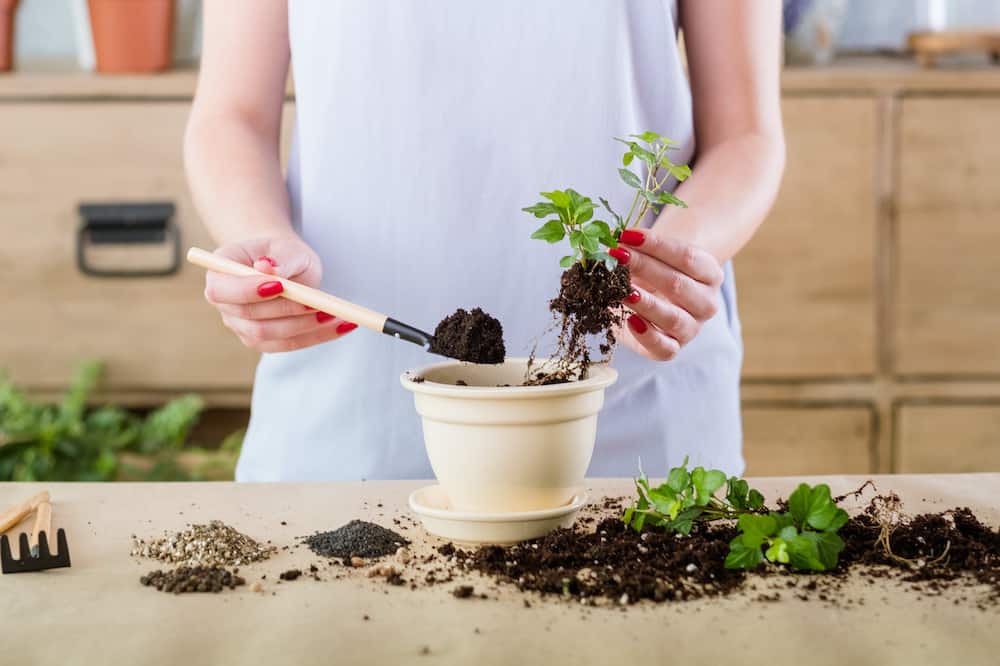Learning how to make plant roots grow faster can help you establish a healthy garden quickly. Whether you’re starting from seeds or cuttings, knowing how to boost plant growth can be essential.
There are several natural and store-bought remedies that you can use to help you promote healthy root growth.
What Stimulates Root Growth?
The most crucial factor that stimulates root growth is nutrients. The more nourished your plants are, the longer their roots will grow. They will be stronger and more adept at withstanding fluctuations with watering.
Over time, they’ll be more tolerant of conditions and will produce a higher yield of fruits or vegetables for you to enjoy.
How to Make Plant Roots Grow Faster
Along with nutrients, which I discuss first, there are other essential factors to pay close attention to. Here’s how to make roots grow faster:
Essential Nutrients
The three most vital nutrients in your plants’ roots are Nitrogen, Phosphorus, and Potassium. You will see this abbreviated as NPK.
With this combination, you’ll give the plants enough energy to turn into food to help build new roots. Adequately nourished plants have stronger existing roots, helping them to grow larger.
Nitrogen does a lot to help plants grow. With regarding roots, nitrogen helps plants develop their root structure.
By using Phosphorus, it enables the beginning states of root systems to grow and promote flowering and root growth.
Potassium is also essential since it thickens the plants’ cell walls, increasing its stress tolerance.
The more stress your plants can handle, the less likely they will die from unexpected shifts in temperature or water quality.
Soil Amendment
When considering how to make plant roots grow faster, another factor is the soil. This critical component to having healthy plants is often forgotten. In addition to fertilizers, there are things you can do to improve the soil.
When you amend your soil, you can improve water retention, aeration, water infiltration, and overall structure. This will all provide a better environment for the roots to grow. The soil amendment needs to be mixed in thoroughly with the existing soil.
Enriching your soil is particularly helpful when you want to start a garden where the soil is poor.
There are several things you can do for enrichment, all of which depend on the soil texture. It’s important to find out what type of soil you have whether it’s a sandy soil, clay soil, or a loam soil. Then you can amend the soil.
You want to factor in permeability and water retention. From there you can determine what to add. This could be fibrous matter, such as wood chips or hardwood bark. It could be humus, such as manure or compost. You may also consider inorganic matter, such as perlite or vermiculite.
Waterings
It might be tempting to over-water your plants, so they have enough moisture, but it can be as bad as watering too little.
It’s helpful to create a chart to remind you how much water each of your plants need for healthy development. It’s important to know how often to water. Over-watering will not make plants roots grow faster. Conversely, under-watering will stunt their growth.
- In pots or planters, be sure to have drainage.
- Keep in mind the climate and season.
- If there’s been rain, you won’t need to water as frequently.
Temperatures
As with any type of plant, the temperature has a significant bearing on promoting root growth. Growing indoors is a way to promote root growth because you can control the temperature.
When trying to root plants quickly inside your home or in a greenhouse, you will have a way to monitor the temperature and humidity levels.
Apart from setting daytime temperatures, you’ll also need to consider nighttime temperatures. Fortunately, you can do all of this using a timer so that your system will adjust itself automatically.
This is also true with growing in hydroponics vs soil. You can have far better control over the roots’ growing conditions with hydroponics, including temperature controls.
When growing outdoors, there are more variables to consider. In traditional soil gardens, you will have less control over the temperature. To stimulate root growth, ideal temperatures are between 65 and 72 degrees Fahrenheit.
This temperature will make sure the roots don’t dry out or freeze from being too cold.
These temperatures, may vary depending on the plants you are trying to root and grow, so you’ll need to take into account specific needs.
When growing soil outdoors, instead of in a traditional garden or raised garden bed, you can grow in portable planters. You will have some control over the temperature in that you can move them in and out of the sun, provide a shade cloth, move them closer to your home in inclement weather, etc.
Lighting
If you are starting plant roots indoors, lighting is key. Plants expect a day-to-night cycle, and as such, you have to do your best to simulate outdoor growing.
So be sure to consider this if you are growing plants on your kitchen counter or have a more extensive setup with a greenhouse.
When growing indoors, a way to promote root growth is with grow lights for indoor plants. For example, bell peppers require an ample amount of sunlight for healthy growth.
You will want to make sure you invest in high-quality lighting setups and bulbs that produce a certain amount of energy.
When you’re working towards growing roots, you can expect to have light shining on your plants for up to 16 hours per day. Consider adding the lighting to a timer to create a natural day to night cycle.
When you want to promote root growth when growing outdoors, it’s important plants have access to morning and afternoon sun for optimum growth.
Management and Care
Ensuring you can manage and care for your plants is one of the sure-fire ways to have a successful garden.
By continually checking up on your plants, you can make any necessary adjustments before the roots are affected by a poor environment.
You’ll want to monitor the water solution’s pH levels, ensure the lighting is adequate, and watch the temperature.
It’s also vital for you to note any potential root diseases such as root rot from over-watering. You’ll also want to note insects or pests that need addressing.
Propagate
Another way to make plant roots grow faster is to propagate plants. Propagating is taking from an existing plant and growing it on its own as a new plant. An example would be snipping a sprig off a basil plant and growing a new basil plant.
Using propagated cuttings is how to make plant roots grow faster than growing them from seeds.
Growing from seed will take longer to establish roots than if you propagate plants.

How to Promote Root Growth?
If you have all of your seeds and cuttings prepared, it’s time to consider how you can promote root growth.
Below, you’ll find some of the best advice for speeding your plants’ growth process.
Rooting Hormones
Plant rooting hormones are one of the most popular options for enhancing root growth. When you use them, your plants will develop faster and healthier than those without rooting hormones.
You can get find plant rooting hormones at garden centers, nurseries, and hardware stores. They come in many forms, although powdered is the easiest.
Most root hormones could contain ingredients called auxins, as well as Vitamin B1.
Sole vitamin B1 won’t stimulate root growth, but auxins are phenomenal for lateral root growth.
However, it should only be used on established plants since it can be poisonous to seedlings.
How to Use Rooting Hormones
When propagating plants, you can use rooting hormone before planting. Gently dip the end of the cutting into the powder, and then plant in soil.
If you grew a plant from seed and are ready to transplant it into a garden plot, you can also use the rooting hormone to give the roots a boost.
It’s best to place the plant under direct sunlight until new root growth begins to establish. Once this happens, ensure the cutting remains sufficiently moist until leaves have begun to form.
NPK Fertilizers
As earlier mentioned, the three ingredients to keep in mind when learning how to promote root growth are Nitrogen (N), Phosphorus (P), and Potassium (K).
With the use of NPK fertilizer, you will ensure the provision of a balanced level of nutrients to your plants.
These pre-mixed store-bought solutions have the ideal percentages of each ingredient to keep your roots healthy.
One of the most significant advantages of NPK fertilizers is that they’re highly adaptable to soil gardens.
If you notice issues with the roots or plants, you can see exactly what that plant requires and add additional nutrients as needed.
How to Use NPK Fertilizers
Before you can add NPK fertilizers to your crops, you need to mix everything to make the nutrient-rich solution. You will need to combine calcium nitrate, Epsom salt, and your fertilizer based on the precise measurements on the packaging in a bucket.
Once this process is complete, you will have a solution packed with essential nutrients that your plants will need.
From time to time, you can check the NPK levels by doing soil tests for your plants to be sure they are getting what they need.
Natural Fertilizers
Another way to stimulate root growth is with natural fertilizers. This can be an organic solution for your garden. A few examples of popular natural fertilizers include:
- Greensand
- Kelp
- Wood ashes
- Bone meal
- Rock phosphate
They are easy to apply. You can simply sprinkle the fertilizer on the soil and mix it in gently.
Some studies also suggest natural bacteria could help to improve root and shoot growth in soil farming.
In addition, consider compost and other soil amendments to provide organic enrichment.

Best Nutrients for Root Growth?
The best nutrients for root growth are nitrogen, phosphorus, and potassium.
They each provide their own set of benefits, but they can cause adverse effects if given in excess.
Hence, before adding NPK fertilizers, you must know the signs of too much or too little of each ingredient.
When one of these or any elements is limiting in the soil, plants’ growth rate slows. This is called environmental dormancy.
Nitrogen
Nitrogen fertilization increases root growth. The primary responsibility of nitrogen is to make sure your plants have rapid vegetative growth.
It also helps make your plants look greener and healthier through all stages.
If a plant has too much nitrogen, you might experience the plant’s foliage is susceptible to stress and damage.
An excess of nitrogen could also result in stunted root growth and far fewer flowers than expected.
It’s also typical for plants with too little nitrogen to experience weak root growth and leaf growth.
Your vegetables will also have yellowing stems and leaves along with low life expectancy.
Phosphorus
By adding phosphorus to your garden, you’ll provide your plants with empowered root growth.
Phosphorus is one of the inorganic macronutrients that all plants need. Plants use phosphorus to make phosphate-containing nucleic acids, membrane lipids, and ATP.
You’ll also notice improved flowering, better fruit sets, and superior disease resistance.
But if your plants have too much phosphorus, they will have fewer shoots and stunted growth while their roots will become too large to handle.
On the other hand, too little phosphorus can lead to lackluster root growth, poor flower development, and no fruit production. Another sign of a phosphorus deficiency in plants is reddening of the leaves.
Potassium
The unique aspect of potassium is that it can be an all-in-one solution for general health.
Often overshadowed by nitrogen and phosphorus when considering how to make plant roots grow faster, potassium is important in root growth and development. Potassium is among the important general regulatory factors of root growth.
With adequate potassium levels, plants will grow strong roots, be generally healthy-looking, and the fruit will ripen as expected.
It also helps with disease resistance, although too little potassium can lead to weak root and shoot development.
Without enough potassium, plants are also far more susceptible to frost and changing temperatures.
You might also notice excessive damage from pests, scorched leaves, and the inability to absorb water.
Too much potassium has a similar response, such as scorched leaves and disease resistance.
How to Make Plant Roots Grow Faster?
Your best option for learning how to make plant roots grow faster is to start with quality soil. From there, combine root hormones with fertilizers and adequate maintenance.
Ensuring you are providing healthy levels of nutrients to all of your plants will excel production. Also, the healthier your garden is, the less it will be affected by disease and pests.
See related:

